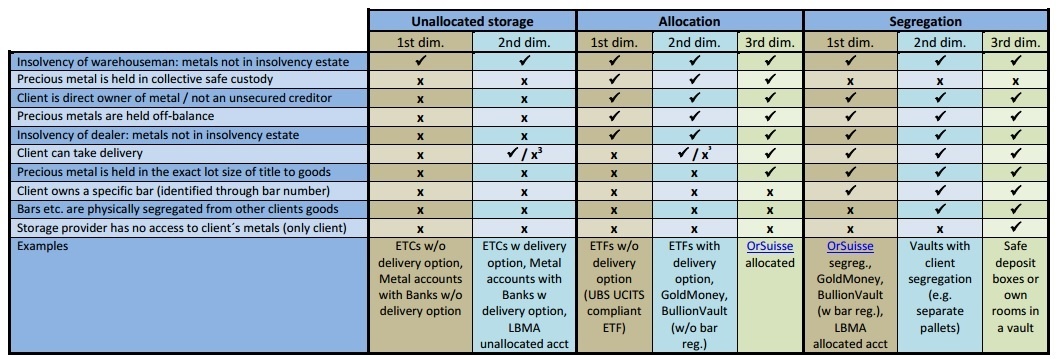The different forms of precious metals storage - simply explained
by Ludwig Karl, published 2nd of August - complete article here
1. Introduction
This paper aims to put the currently existing ways of precious metals storage in one simple schematic. It presents for the first time a more extended schematic of looking at the different forms of storage besides the simple distinguishment between unallocated and allocated forms.
It introduces a third form of storage, herein called segregation and separates each form into different dimensions.
While this paper does not discuss alternative payment systems based on gold and silver it recognizes them as a valid means of conducting business. This paper focusses more on the separate major forms of storage and their possibilities including examples.
(...)
2. The unrefined current way of looking at the separate ways of storing precious metals
Current discussions in the subject make a differentiation generally between two forms of storage.
It is mainly based on the LBMA's operation in separating client's accounts into an unallocated and an allocated form which will be used as an example herein.
A schematic comparing the two ways of storage looks like this:
2.1. The unallocated way of storage
The unallocated account at the LBMA is mainly characterised by being an unsecured creditor to the dealer with whom one holds an account.
Whereas the dealer is required to hold the precious metals in stock in the same amount precious metals ‘credits' were issued, the client does not hold title to a specific bar or lot size.
‘Credits' to precious metals have to be ‘allocated' with the dealer into specific bars before being able to take delivery.
In the case of an insolvency of the dealer the bullion which was held against the precious metals ‘credits' will be put into the insolvency estate.
2.2. The allocated way of storage
When holding an allocated account with a dealer at the LBMA the client will receive ownership to a specific bar stored at a warehouse. Identification of the bar usually happens via bar numbers and further details. This enables audits and the client is no longer an unsecured creditor.
The specific bar belongs directly to the client.
In the instance of an insolvency of the warehouseman or the dealer the bullion will still remain in the ownership of the client and will not be a part of the insolvency estate.
3. Schematics: the refined new way of looking at the separate ways of storing precious metals
The increasing size of the precious metals markets in the last few years has brought several new ways of buying and storing bullion.
The author proposes a refinement of the current distinguishment between the different forms of storage and will hence redefine several terms used in storage to reach this goal.
The current two forms of storage (Allocation and Unallocated storage) are extended by a third:
Segregation
Every form of the three will further be re-fined by at least two dimensions increasing with the numbers in security for the client:
While unallocated storage exists in two dimensions, allocated and segregated exist in three dimensions.
A diagram of all of them looks like this:
(...)

